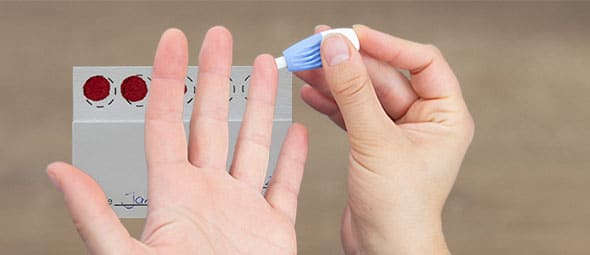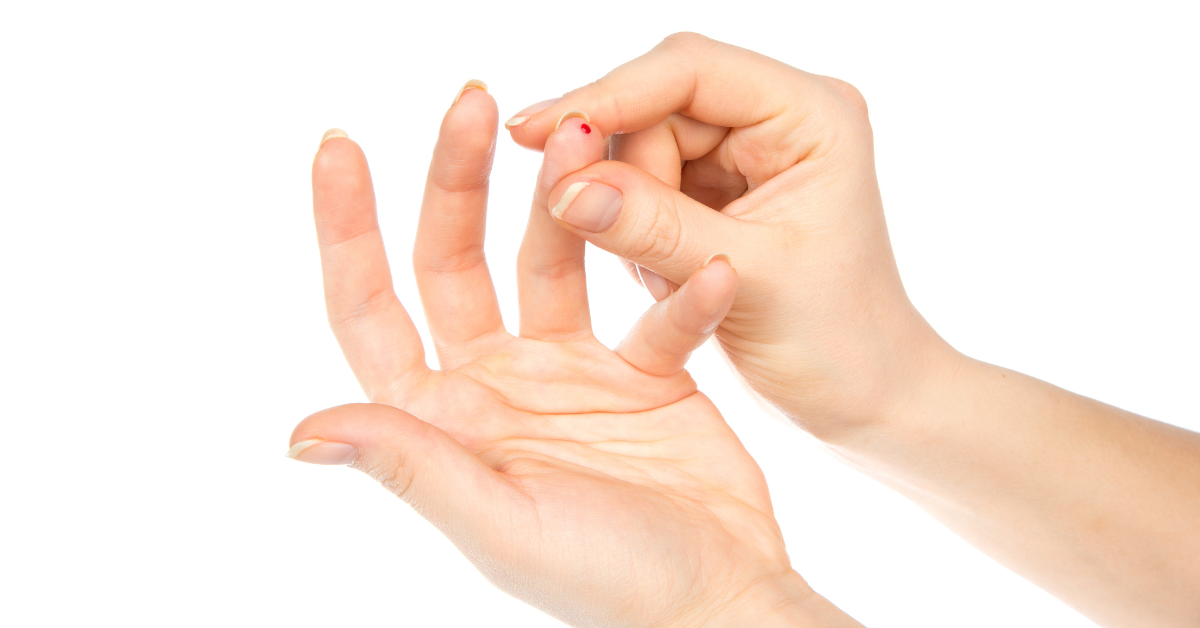Blood tests are often something people would like to avoid, either due to fear, discomfort, or difficulty collecting an adequate sample. Traditional sampling methods usually involve visiting a clinic, a method that can be stressful and takes time. As such, Dried Blood Spot (DBS) testing is now increasingly used for its ease and convenience. DBS testing is a blood collection method in which droplets of blood are deposited onto a paper card for analysis. The blood is usually obtained through a finger prick and can be performed from home. This method is an alternative to traditional blood sampling methods, which often involve taking a sample from a vein in the hand or inner arm and filling one or more test tubes with blood. Read on to learn more about how DBS testing works and how Homed-IQ uses this method to make taking a blood sample more comfortable.
How to take a dried blood spot sample
Homed-IQ tests that use DBS contain everything you need to take the sample. Make sure to activate your test before you begin.
Step 1:
Start by writing your name and the date on the blood testing card. Next, wash your hands with warm water and dry them. Hold your hands against a cup of warm water for 2 minutes and vigorously swing your arms at your sides 8-10 times to stimulate blood flow. Take the caps off the lancets.
Step 2:
After this, select the site of your finger prick. Disinfect the fingers using the included wipes and let them dry completely before proceeding. It is now time to take the sample. To do this, press the lancet firmly against your finger until you hear a click. Wipe away the first blood droplet that appears with the disinfecting wipes.
Step 3:
Now, stand up and keep your hand below chest height. Massage the finger from the hand towards the prick site so that a large blood droplet forms. Be sure not to press too hard on the fingertip as this can damage the blood sample. Hold the finger over the blood testing card and allow the blood droplets to fall onto one of the marked circles without touching the card. If the blood droplets don’t fall freely, you can carefully touch the blood droplet to the card without allowing your finger to come into contact. Fill one circle completely until you move onto the next one. Repeat this for the next four circles, or until it is no longer possible to draw blood. If needed, you may use the other included lancets to prick a different finger.
Step 4:
After the blood sample is complete, let the blood testing card dry for 3-4 hours away from heat or moisture.
To watch a demonstration of how to take a try blood spot sample, watch the following video:
Mailing a dried blood spot sample
Once the DBS sample is dry, it is ready to return to the laboratory. Simply place the testing card in the supplied protective bag and seal it. Next, put it in the shipping box. You may now return the test by regular post. Homed-IQ tests also include prepaid postage.
Analysis of dried blood spot tests
Once in the laboratory, a sample is taken from the blood testing card using a hole punch, followed by a procedure to extract and measure the blood sample. This is why it is important to try and fill the circles on the blood testing card as completely as possible, and fill one circle completely before moving on to the next circle on the card. It is better to fill some of the circles completely rather than placing a few drops in every single card. After the sample is extracted and prepared, specific analysis of the blood is performed.
Automation of machines in the laboratory means that thousands of DBS tests can be processed in a single day. This means the time period between your test arriving at the lab and receiving the results should be relatively short.
Receiving your dried blood spot test results
After laboratory analysis is complete, the results of your DBS test will appear online in your Homed-IQ account. Please remember that your test cannot be processed by Homed-IQ unless it’s activated.
Are dried blood spot test samples stable?
DBS tests have been found to be highly stable in a range of weather conditions, over extended periods of time (Miesse et al., 2022). This means that you can drop your test in a nearby mailbox in almost all weather conditions, and do not need to worry about the sample waiting over the weekend to be picked up. In the rare event of extreme cold or heat, it is recommended to bring the test to a post point rather than leaving it in a mailbox.
How reliable is dried blood spot testing?
DBS testing has been found to be a reliable alternative to traditional venous blood samples, including in the context of SARS-CoV-2 antibody testing. All DBS tests are scientifically validated, meaning they are compared to the results from a regular venous blood sample to see that the results are similar before it is approved for use.
What if I struggle to take the blood sample?
Some people may struggle to get enough blood to fill all the circles on the blood testing card. This can be for a variety of reasons, such as callouses on the fingers, dehydration, or poor circulation. If you struggle with taking the sample, try and fill at least one circle on the test card before the others. Before pricking your finger again, warm up your hands under running water or simulate blood flow by swinging your arm at your side. Click here to read more about tips to make your blood sample successful.

Can all blood tests be performed with dried blood spot testing?
Dried blood spot testing is only suitable for certain types of blood tests, such as Homed-IQ’s Blood Sugar Test. However, all Homed-IQ blood tests use a finger prick method for obtaining the blood sample, eliminating the need to visit a doctor for a venous blood draw.
What is dried blood spot testing used for?
DBS testing has a variety of applications and continues to be validated for use in different types of tests. In the past, DBS was predominantly used for screening newborns for certain diseases shortly after birth, a common procedure known as the heel prick test. DBS is also used in infectious disease screening, as the stability and ease of use allow DBS samples to be collected and analyzed in low-resource or remote locations. In fact, the WHO has recommended DBS for monitoring hepatitis B, C and HIV in remote areas that do not have clinical or laboratory facilities (Garza & Clarke, 2022). DBS is being increasingly used for therapeutic drug monitoring, which measures how much drug is in an individual’s blood to determine if the dose they are taking is safe and effective. In this context, DBS has many benefits, such as allowing the patient to test from home and requiring smaller amounts of blood. Finally, DBS is also used for toxicology, such as testing for drugs or environmental contaminants. The uses of DBS continue to grow, especially as public health organizations and governments take interest in using this method to make blood tests easier and more accessible for everyone.
References
Brinc, D., Biondi, M. J., Li, D., Sun, H., Capraru, C., Smookler, D., Zahoor, M. A., Casey, J., Kulasingam, V., & Feld, J. J. (2021, May 22). Evaluation of Dried Blood Spot Testing for SARS-CoV-2 Serology Using a Quantitative Commercial Assay. Viruses, 13(6), 962. https://doi.org/10.3390/v13060962
Miesse, P. K., Collier, B. B., & Grant, R. P. (2022, April 6). Monitoring of SARS-CoV-2 antibodies using dried blood spot for at-home collection. Scientific Reports, 12(1). https://doi.org/10.1038/s41598-022-09699-4
Garza, K., & Clarke, W. (2022, September 1). Dried blood spots and beyond. AACC. Retrieved September 29, 2022, from https://www.aacc.org/cln/articles/2022/september/dried-blood-spots-and-beyond





